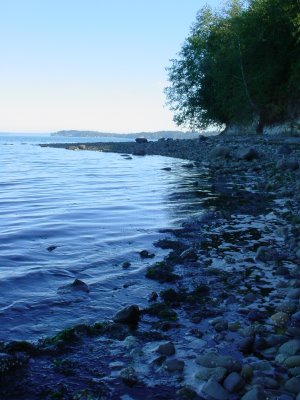 This was the sign that greeted us at Lake Anderson on Saturday, where we had hoped to do some canoeing. Officer Boice was there to greet us, and to explain that "Blue-green Algae Bloom" has caused the lake to be off limits to anyone - boaters and swimmers. The whole area is roped off due to this algae, which, when ingested by dogs, can kill them. Two dogs died from drinking the lake water earlier this summer.
This was the sign that greeted us at Lake Anderson on Saturday, where we had hoped to do some canoeing. Officer Boice was there to greet us, and to explain that "Blue-green Algae Bloom" has caused the lake to be off limits to anyone - boaters and swimmers. The whole area is roped off due to this algae, which, when ingested by dogs, can kill them. Two dogs died from drinking the lake water earlier this summer.Officer Boice indicated that blue-green algae, or Cyanobacteria, typically occurs in lakes rich with nutrients like phosphate. The algae can multiply rapidly to form extensive "blooms" that accumulate near shore as a thin bright green surface scum. When a bloom dies, the water surface may become colored with a mixture of bright blue and white material, often mistaken for a paint spill. She said "While not all blooms turn toxic, many of them have the ability to do so and it can happen very quickly."
As we explored possible coves and bays along Puget Sound, we found that the Washington State Department of Health had closed quite a few beaches due to Paralytic Shellfish Toxin, or Red Tide. When we found Oak Bay, I noticed that a warning sign was posted that prohibited gathering clams, oysters, mussels, and scallops.
 These signs are printed in a variety of languages, so clam-diggers have the necessary infor- mation to protect themselves. Eating shellfish contaminated with this biotoxin is harmful to humans. If a person consumes enough poison, muscles of the chest and abdomen become paralyzed and death can result in as little as two hours, as muscles used for breathing become paralyzed. The toxin is not destroyed by heating or freezing, and the toxin can remain in shellfish long after the algae bloom is over. Shellfish containing toxic levels of Paralytic Shellfish Poisoning don't look or taste any different from non-toxic shellfish. Tests are routinely done on beaches in Puget Sound by the Health Department, and all suppliers of shellfish to restaurants have routine tests. For serious shellfish harvesters, the Washington State Department of Health provides a marine biotoxin bulletin that indicates where harvests can occur.
These signs are printed in a variety of languages, so clam-diggers have the necessary infor- mation to protect themselves. Eating shellfish contaminated with this biotoxin is harmful to humans. If a person consumes enough poison, muscles of the chest and abdomen become paralyzed and death can result in as little as two hours, as muscles used for breathing become paralyzed. The toxin is not destroyed by heating or freezing, and the toxin can remain in shellfish long after the algae bloom is over. Shellfish containing toxic levels of Paralytic Shellfish Poisoning don't look or taste any different from non-toxic shellfish. Tests are routinely done on beaches in Puget Sound by the Health Department, and all suppliers of shellfish to restaurants have routine tests. For serious shellfish harvesters, the Washington State Department of Health provides a marine biotoxin bulletin that indicates where harvests can occur.  Since this toxin is harmful only if shellfish are eaten, the beaches were open for canoeing, and for walking pets.
Since this toxin is harmful only if shellfish are eaten, the beaches were open for canoeing, and for walking pets. We spent about an hour paddling out to sandstone outcroppings and gliding through seaweed that packed the shoreline. Then the tide started to roll in, with massive swells lifting the canoe up and down. I packed a lite meal of cheese and crackers, and we glided back to our put-in place just as the sun was starting to set. It was a very quiet day on Puget Sound.
We spent about an hour paddling out to sandstone outcroppings and gliding through seaweed that packed the shoreline. Then the tide started to roll in, with massive swells lifting the canoe up and down. I packed a lite meal of cheese and crackers, and we glided back to our put-in place just as the sun was starting to set. It was a very quiet day on Puget Sound.